The CELTIC, the first unit of the ‘Big Four’ of the White Star Fleet, ran aground on December 10, 1928, off Queenstown (today: Cobh). On December 10, 2023, it was 95 years ago. In commemoration of the anniversary, we recall the history of the design, building and service events of the type of ship immediately preceding the famous OLYMPIC-class, with the help of CELTIC's chronology.
Fig.1.: The R.M.S. CELTIC in an Atlantic storm (drawing: Dr. Tamás Balogh).
18.01.1868.: The British Thomas Henry Ismay (1837-1899), director of the National Line shipping company, shareholder of the English shipping company, White Star Line (WSL), founded in 1845, buys the name, symbols and goodwill of the company for 1,000 pounds, and then founds his own company under the name Oceanic Steam Navigation Company (OSCN). OSNC is financially supported by Gustavus Schwalbe, a German banker and shipowner from Liverpool, if the company orders its ships exclusively from the Harland & Wolff (H&W) shipyard in Belfast, where Schwalbe's nephew, Gustav Wolff, is a co-owner. Ismay accepts the deal if H&W also undertakes not to build ships for WSL rivals.
30.07.1869.: OSNC's first order from H&W for the construction of the company's first ship, the later OCEANIC (I.). In order to operate the OSNC, Ismay partners with William Imrie, the owner of the Imrie and Tomlinson Company (this company is William Imrie's paternal legacy, and together with Ismay both trained here as aprentice) and William Samuel Graves, and together they create the Ismay-Imrie and Co., which continues to operate as the parent company of OSNC. OSCN, led by Ismay, will be responsible for steamships, and North West Shipping Company (NWSC), led by Imrie, will be responsible for operating sailing ships.
Fig. 2.: Builders of a shipping empire: Thomas Henry Ismay (1837-1899), Gustav Christian Schwalbe (1813-1897), Gustav Wilhelm Wolff (1834-1913) and Sir Edward Harland (1831-1895).
27.08.1870.: With the launch of its steamship OCEANIC (I.), the WSL shipping company led by Thomas Henry Ismay begins building its fleet of new passenger ships. The first unit will be followed in the next two years by three more identical ships (ATLANTIC, BALTIC, REPUBLIC) and two more ships of slightly increased size (ADRIATIC, CELTIC) built according to the same plans. Thomas Henry Ismay's goal is to create a fleet that provides the best - the most elegant, the most comfortable, the safest and the fastest - service in the North Atlantic traffic.
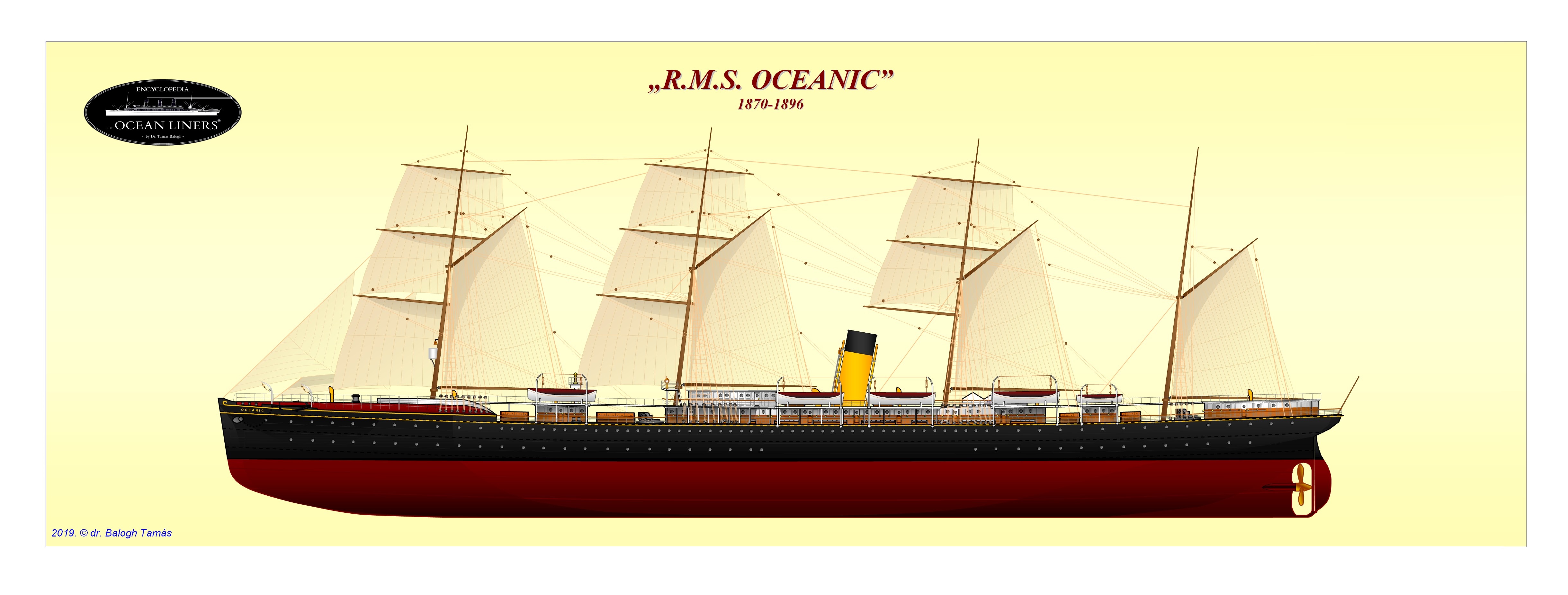
Fig. 3.: OCEANIC and her sisters were the very first ocean-going passenger ships in which the "box-like" hull shape with flat bottom, developed by Sir Edward Harland in 1867 (and used only on cargo ships until then) was used, abandoning the semicircular or its approximate segmental arc shape, which was considered indispensable for the continuous recovery of the balance of the ship tossing and swaying by the waves in the transverse direction. White Star ships were long and narrow, with a completely flat bottom in the middle, connected to the vertical sidewalls only by an curve of a very small radius. Their critics called them "coffins" because of their box-like shape and were convinced that they could not withstand the storms during the ocean crossing. However, Harland also made the decks out of iron, adding internal reinforcement to the box girder (the hull), formed by and assembled from the side-frames. Contrary to the claims of the skeptics, the flat bottom of the ship would not have reduced it, but actually increased the stability, since by the angularization of the previously strongly curved bottom increased the storage and the load capacity of the ships on underwater parts, which kept the center of gravity low, reducing the rolling to a minimum. Moreover, the new ships not only had a larger transport capacity than their rivals, but were also faster. The not-so-flattering epithet "coffin" was thus soon replaced by the amazed expression - mixed with wonder and respect - of "greyhound". In particular, the increased stability by increasing the volume of the underwater parts allowed the installation of larger windows on the upper decks, so that all the interior spaces on the ships of the White Star Line were spacious and bright. The general arrangement of the ships was subordinated to the needs of the first class, insofar as the first class accommodations and communal rooms were designed in the middle of the ship, the farthest from the vibrating and noisy machines, and at the same time the most balanced place, while the third class accommodations were placed in the bow and stern of the ship - with accommodation for single men at the bow, single women and families at the aft. In first class, for the first time, they could create a large dining room in which there was no need for rotating catering: all passengers could take a seat at their own table at the same time and call their stewards by ringing an electric bell to their staterooms and suites, based on the comfort and impressive appearance of which, according to the press of the time, the OCEANIC was "more of an imperial yacht than a passenger ship", which "inaugurated the White Star Line as the arbiter of comfort in the North Atlantic". (drawing: Dr. Tamás Balogh)
02.03.1874.: BRITANNIC (I.) and her sister ship GERMANIC, built a few months later - the first two-funnelled ocean liners of the WSL - continue to enhance the excellence introduced by OCEANIC and her sisters.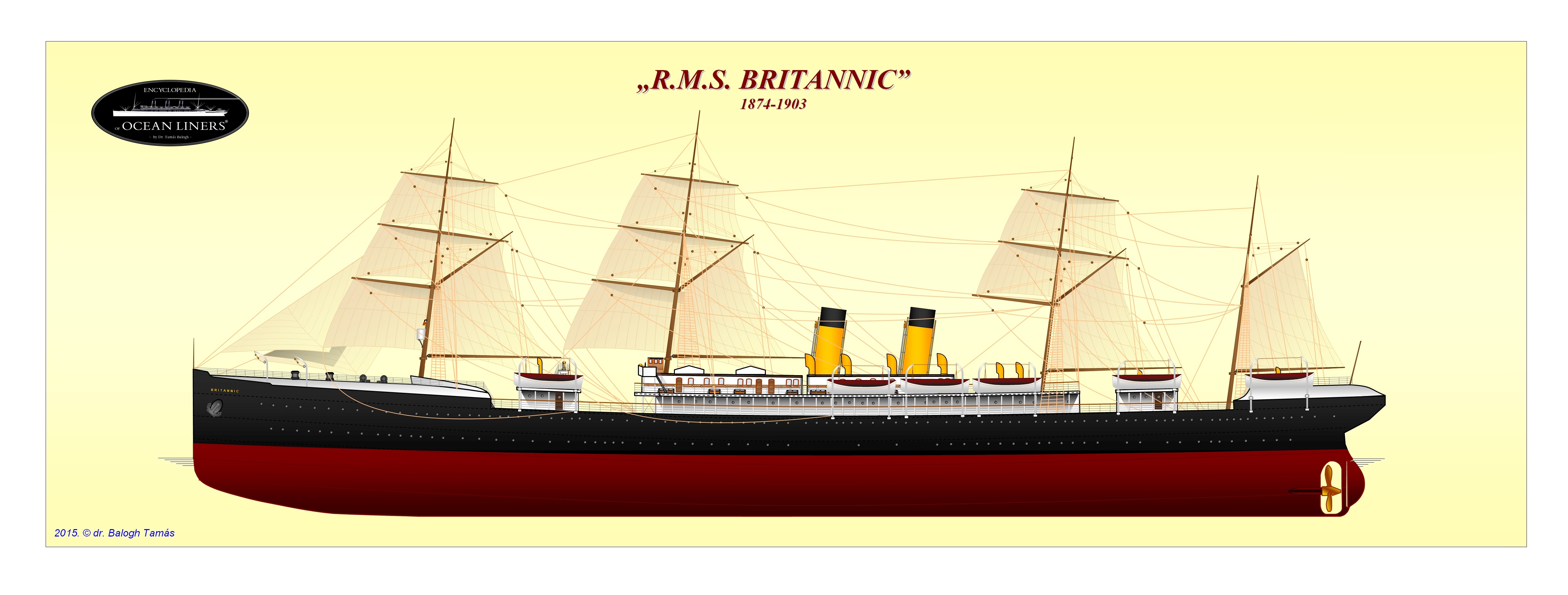
Fig. 4.: On the ships, not only the well-known hull shape, increased stability, spacious and bright interiors, and lavish furnishings increased the comfort of the passengers, but also the ventilation system operated by a steam-powered fan, which provides hot or colda air to all parts of the ship as needed. Although, like the ships of the time, even the ships of the White Star Line were propelled by only single screw (therefore they were equipped with four masts of auxiliary sails to avoid unmanevourability due to engine failure), the ships crossed the Atlantic at record speeds (the speed record for the westbound crossing was held by the BRITANNIC until 1877, and by GERMANIC until 1882, and both kept the speed record of the eastbound crossing until 1876). BRITANNIC served until 1899, when she was used by the British government for troop transport purposes in the Boer Wars, and was scrapped in 1903, while the GERMANIC remained in the WSL fleet until 1910, when she was sold to Turkey, where she served until 1950. (drawing: Dr. Tamás Balogh)
19.01.1889.: Launching of the first unit of the TEUTONIC class, a new type of ocean liners ordered to replace the OCEANIC class - which was gradually becoming more and more obsolete - and replace the two ocean liners lost from the class, the ATLANTIC and the BALTIC.
Since Thomas Henry Ismay tried to obtain government support for the construction of the new ocean liner by negociating with the Admiralty: in case of governmental support, the ship will be built in accordance with the needs of the navy (this offer and its acceptance lead to the signing of the so-called British Auxiliary Armed Cruiser Agreement), TEUTONIC takes part in the fleet review equipped with guns, making deep impression to Kaiser Wilhelm II., who declares at the end of his visit: "we must have some of these" ships. TEUTONIC thus become the incentive of the German ocean liner construction program. 
Fig. 5.: "The Emperor's visit to the TEUTONIC - Inspecting the 6-inch quick-fireing gun." – illustration from the Sunday issue of a British illustrated magazine, 'The Graphic' of August 10, 1889.
The start of the British armed merchant cruiser program was hastened by the practice of arming ocean liners, ordered in Great Britain to supplement the units of the Tsarist Russian Navy (i.e. the establishment of the Russian Volunteer Fleet in 1878), since Great Britain, under such circumstances, felt it necessary to protect its maritime commerce from the Russian commercial raiders by putting similar vessels into service. As a consequence of this, the offer of Thomas Hery Ismay was favorably received by the British government and, from 1889, the mail transport contracts concluded with civilian shipping companies were supplemented with the provisions of an auxiliary cruiser construction and operation agreement.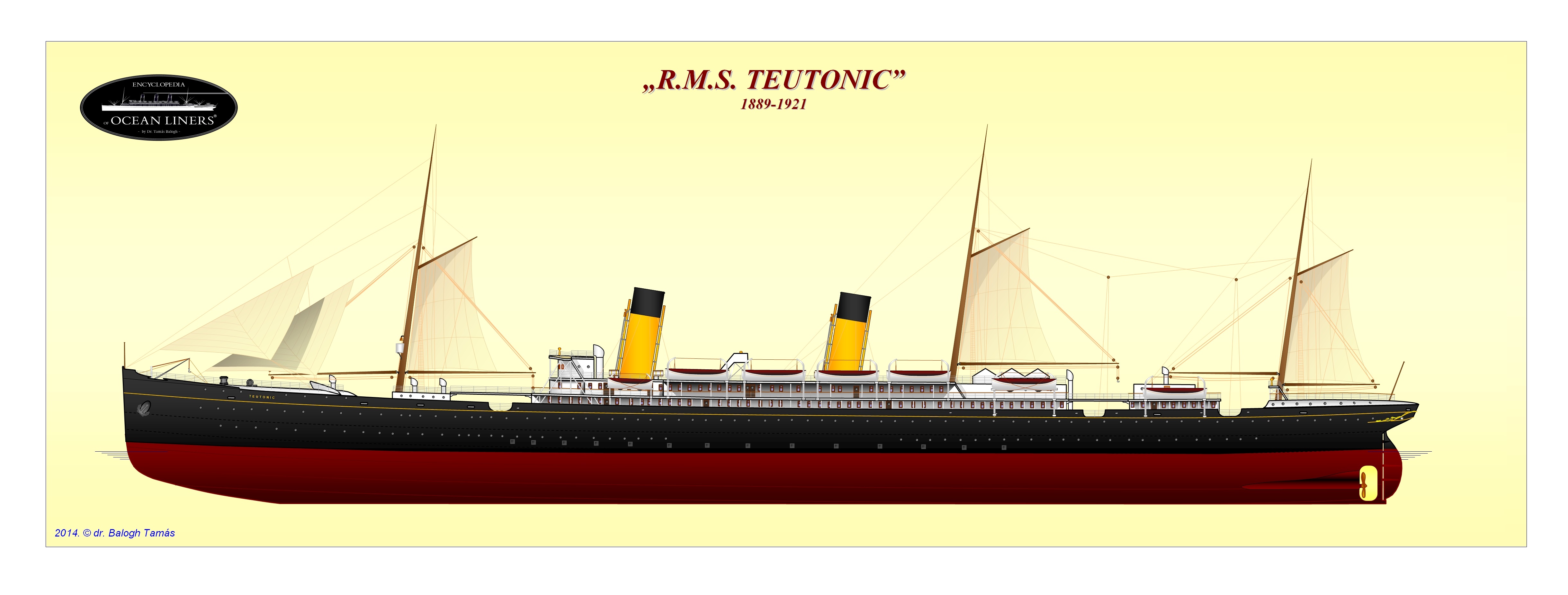
Fig. 6.: While the displacement of the OCEANIC-class ships was only 3,807 tons, and that of the BRITANNIC-class ships was 5,004 tons, the displacement of the TEUTONIC and her sister, the MAJESTIC (I.), reached 9,984 tons. In parallel with the increase in size, the machine power (number of boilers, space for of engines and coalbunkers) had to be increased as well. The ship's plans were drawn up with a view to winning back the "Blue Ribbon", honorary award for the fastest Atlantic crossing for the WSL by setting a speed record, and at the same time she was made suitable to act as an armed merchant cruiser to join the navy in case of war. When her plans were presented to the Admiralty, they enthusiastically described them as "the best ship design ever made". The ship's designer, H&W engineer Alexander Carlisle, would prove his ability many times later. (drawing: Dr. Tamás Balogh)
17.05.1895.: Scrapping of OCEANIC. The WSL's North Atlantic fleet is once again in need of additions. Preparations begin for the construction of another large class of ships. The development is influenced by several aspects.
On the one hand, by the end of the 1890s, WSL's highly prestigious TEUTONIC-class ocean liners were challenged by competitors: the British Cunard Line introduced the sister ships CAMPANIA and LUCANIA in 1893, and Germany's Norddeutscher Lloyd presented the plans for KAISER WILHELM DER GROßE, the first of its four new KAISER-class ocean liners to be built based on the experience of Kaiser Wilhelm II's visit to the Spithead naval review. To compete with these ships, the WSL needed a new flagship.
On the other hand, shipowners primarily wanted a return on their investment when they placed an order for the construction of a new ship. But the profitability was precisely that which had to be sacrificed on the altar of speed records at that time: a single knot of speed increases already required such an amount of extra fuel, machinery and personnel (trimmers and firemen) that the budget could no longer be based only the income from ticket, postal and freight charges. Especially since the increase in space requirements for coal and engines took away the space from the commercially important passenger and cargo spaces.
Moreover, for the majority of passengers, arriving at their destination a few hours earlier than the ships of the rival company had less and less appeal, especially if the powerful vibration of the engines, which were running at full power, made the journey miserable for them. And by this time, the world's public is used to the fact that shipping records don't last forever, only for a few months, before building another liner which will be bigger and/or faster.
The result of a sober calculation was thus a preference for size and comfort over speed, which resulted in new ship designs that (although not the largest in the world) were larger than the TEUTONIC and MAJESTIC, or the CAMPANIA and LUCANIA , but they are not faster than those.
01.09.1897.: Laying of the keel of the first WSL steamer, CYMRIC, built according to the new concept.
Fig. 7.: The ship was originally designed as a combined passenger and cargo ship that would have accommodated only first class passengers, with all other space reserved for the transport of live animals (cattle). However, the idea of the joint transport of passengers and livestock proved to be too unpopular already during the planning period, so third-class accommodations were planned instead of the cargo spaces without making any modifications to the relatively moderate-performance machinery. Thus, using the large interior provided by the previous cargo holds and the relatively small engine room, a ship was created that was relatively slow compared to speed-oriented fast passenger liners, but had much more interior space and, as a result, an unusually high level of comfort. In addition, the machines with lower power generated less noise and vibration, which on the one hand reassured the passengers, and on the other hand resulted in much lower operating costs. (drawing: Dr. Tamás Balogh)
Cymric introduces the 'luxury over speed' strategy. White Star Line is pursuing this strategy as it places another order with Harland & Wolff Shipyard to design new ships after all but one of the line's first six ships (the OCEANIC class) have left the WSL-fleet. From the beginning, the design follows two directions:
On the one hand, they decide that the new strategy will be adapted to the new class of ships designed by further developing the plans of the TEUTONIC class, in which (as in the basic type) two more ships will be built, which will be named OCEANIC (II) and OLYMPIC, with only 21 knots (39 Km/h) service speed (which is advantageous for a schedule-planning, because in this way they can keep up with TEURONIC and MAJESTIC, which are capable of the same speed, and they will also be able to fulfill the conditions of the auxiliary cruise agreement), but they do not increase their speed more than that, since they are not expected to set a speed record.
On the other hand, specifically by further developing the plans of CYMRIC, four other ships will be built, optimized for the rather average speed of 16 knots (30 Km/h), but with uniquely large dimensions, large cargo spaces and lavishly furnished, spacious staterooms. For now, this type is only known as: the "Big Four".
With this, according to the plans, four fast steamers (TEUTONIC, MAJESTIC, OCEANIC (II), OLYMPIC) and four cobined (passenger and freight) steamships of moderate speed but extremely high capacity would make up the WSL's North Atlantic fleet.
The customer specification handed over to the designers is determined by Thomas Henry Ismay, based on the "luxury over speed" strategy for both types: "Nothing but the very finest!" In the case of the OCEANIC (II) class, all of this means the construction of the longest ships in the world, and in the case of the "Big Four" the world's largest (displacement) ships. According to his calculations, this means that the British will continue to claim primacy in terms of all the characteristic performance of shipbuilding, since the fastest, longest and largest ships in the world would be built by British shipyards and operated by British companies. And WSL enjoys the glory of not having to participate in the rather expensive sport of building and operating high-speed ocean liners in the future (since it is relinquishing that glory to rival British shipping company Cunard Line in order to operate financially sustainably).
18.03.1897.: Keel laying of OCEANIC (II) at H&W in Belfast.
05.04.1897.: Launching of the German ocean liner KAISER WILHELM der GROßE.
04.03.1898.: KAISER WILHELM der GROßE conquers the Blue Ribbon at a speed of 22.29 knots (41.3 Km/h) from the Cunard liner LUCANIA. It is the first time that the largest and fastest ship in the world is not British, but German. From then until October 1907, the honorary award for the fastest Atlantic crossing was exclusively held by various German ocean liners. The "German decade" of transoceanic passenger traffic begins. The hurted British national pride is looking for satisfaction, so the planned WSL ships - the OCEANIC(II) class under construction, and the Big Four to be built immediately after - suddenly become the center of interest, since they have to regain at least the distinguished title of world's longest and largest ships from the Germans.
09.10-12.1898.: Exchange of letters between the White Star Line shipping company and the Harland & Wolff Shipyard regarding the conclusion of the contract confirming the order for the first unit of the Big Four.
14.01.1899.: Launch of OCEANIC (II) at Belfast. The 215 m long new WSL steamer is the first ocean liner to surpass the 211 m length of the famous GREAT EASTERN giant steamer built 40 years earlier.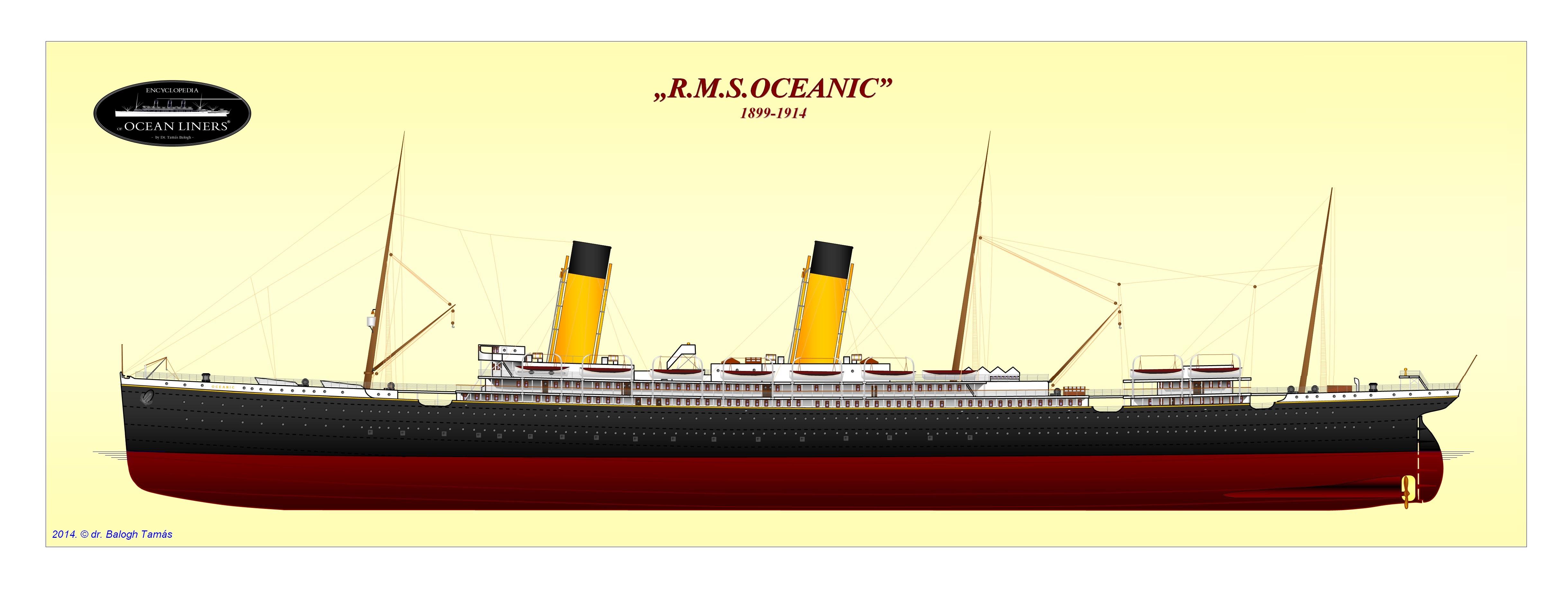
Fig. 8.: The 17,274-ton OCEANIC (II) required 15 boilers to maintain her non-record speed of 21 knots. In comparison, the 12,552 ton CYMRIC needed only 7 boilers and much less coal (6,996 tons compared to 8,123 tons) to maintain its speed of 15 knots (27.8 Km/h), while much larger passenger and cargo space was available, due to the limited extent of the boiler- and engine-rooms. In other words, even though the OCEANIC (II) was a larger ship, the CYMRIC could be used better for the profitable transport of passengers and goods despite her smaller dimensions. The 21 January 1900 issue of The Graphic magazine nevertheless gave an enthusiastic account of the launching: "On Saturday there was launched from Messrs. Harland and Wolff's Yard, at Queen's Island, Belfast, the new twin-screw steamer OCEANIC, which has been built for the White Star Line. The event will mark an era in the history of shipbuilding as a feat of engineering, for the Oceanic is the largest vessel ever built.” For its construction, a new gantry crane was needed at the H&W shipyard, and hydraulic riveting was used for the first time. (drawing: Dr. Tamás Balogh)
After launching the OCEANIC, Thomas Henry Ismay complains of chest pains. Since he was rarely sick throughout his life, his doctor takes his complaints very seriously, despite this, Ismay's condition slowly but steadily worsens. The order for OCEANIC's sister ship is delayed.
12.02.1899.: OCEANIC (I)'s sister ship ADRIATIC scrapped (and broken up at Thomas W. Ward's shipyard, Preston). This completes the decommissioning of the WSL's first class of ships (ATLANTIC sank in 1873, BALTIC and REPUBLIC were sold to the Netherlands in 1888/1889, CELTIC to Denmark in 1893, OCEANIC was demolished in 1895).
22.03.1899.: The keel of the first unit of the Big Four laid with yard number 335. Thomas Henry Ismay's health is beginning to improve. He travels with his wife to Windermere, where he is again ill. His wife calls a doctor, who prescribes morphine. After six days, Ismay feels better and they return to Dawpool.
26.04.1899.: After six weeks of intense pain - which the doctor diagnosed as gallstones - Ismay feels well enough to work again.
30.08.1899.: Ismay collapses and is forced to bed. He is operated on the next day, but the operation is unsuccessful.
01.09.1899.: The bottom frames of the hull No. 335 is completed up to the height of the double bottom.
04.09.1899.: Ismay's second operation.
05.09.1899.: Ismay insists that his daughters take part in the OCEANIC's maiden voyage starting the next day, and asks his wife to arrange for the local church to pray for her.
14.09.1899.: Ismay has a heart attack.
23.11.1899.: Ismay dies at the age of 62. He was succeeded as president of the White Star Line by his eldest son, Joseph Bruce Ismay (1862-1937), who returned to the UK in 1891, after 10 years in New York as an agent for the company. The order of OLYMPIC is cancelled. J. Bruce Ismay devotes his full attention to the construction of the last class of ships ordered by his father, the Big Four.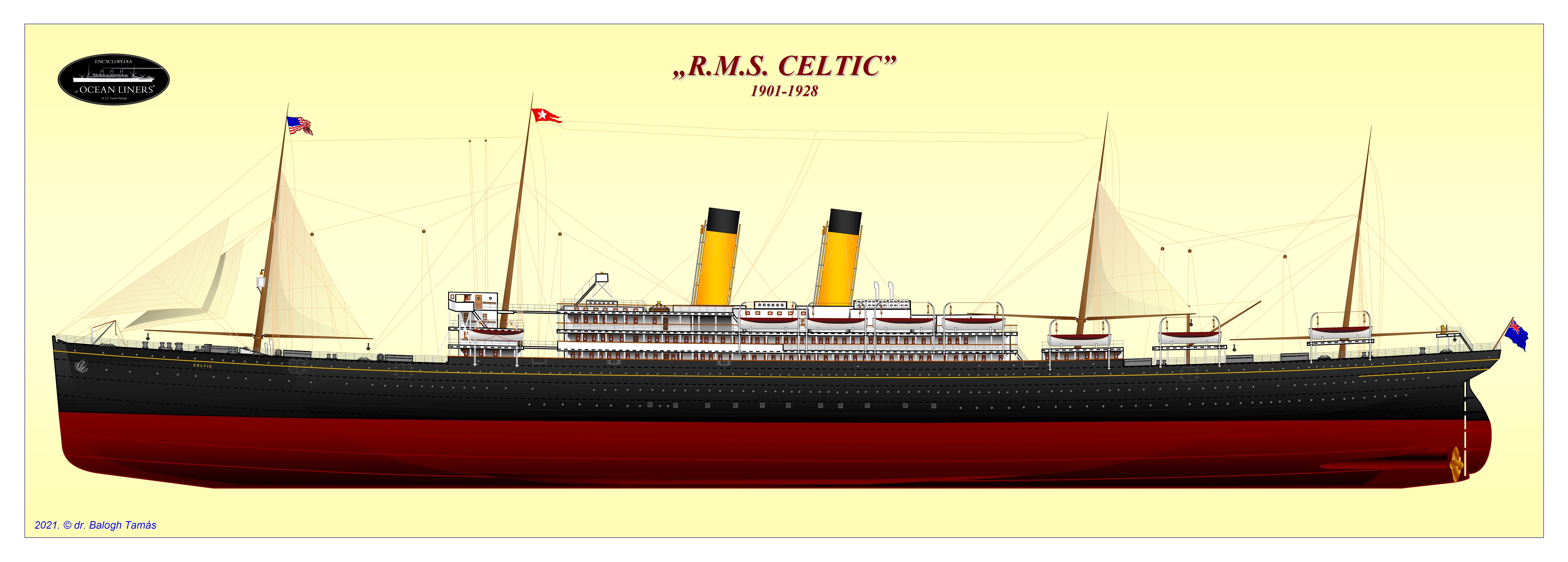
Fig. 9.: The hull No 335 is the same 680 feet (211 m) length as the GREAT EASTERN with a beam of 75 feet (22.86 m), making her displacement well above that of the largest ship to date (20,904 GRT compared to 18,915 GRT). With this, after OCEANIC (II) - which exceeded its length - the displacement of GREAT EASTERN is also exceeded, but the length-to-width ratio of the hull is greater compared to the OCEANIC (II) as well (9:1 compared to 10:1). The displacement of the Big Four is thus 21% larger than the displacement of the OCEANIC (II), and her interior spaces can be used much better, as she is built with only half as many (8) boilers compared to the 15 boilers of the OCEANIC (II). The large dimensions of the hull require special care during construction in order to ensure resistance to the torsional and shearing stresses caused by ocean waves (to avoid splitting the hull resting on two wave crests, floating above a wave valley in the middle, or a hull resting on a wave crest in the middle, floating above a wave valley at both ends). For this purpose, the lateral row of plates along the upper deck of the ship's hull and the plating of the middle section of the ship's bottom are doubled, and the deck frames are supported with columns. While in the case of the OCEANIC (II) the general arrangement was created based on the plans of the TEUTONIC class, and the navigation bridge was integrated with the superstructure (giving the ship an elegant, continuous appearance), in the case of the "Big Four" it was divided according to the plans of the CYMRIC (resulting a split superstructure called with the contemporary terminology an "island" superstructure), on which the superstructure containing the navigation bridge and the officers' quarters are separated from the other parts of the superstructures available to passengers. (drawing: Dr. Tamás Balogh)
01.24.1900.: The complete framing of the hull No 335 is completed.
13.10.1900.: The second unit of the Big Four (yard number 337) is laid.
04.04.1901.: Launch of hull No. 335 under the name CELTIC.
11.07.1901.: Official handover of the ship to the WSL.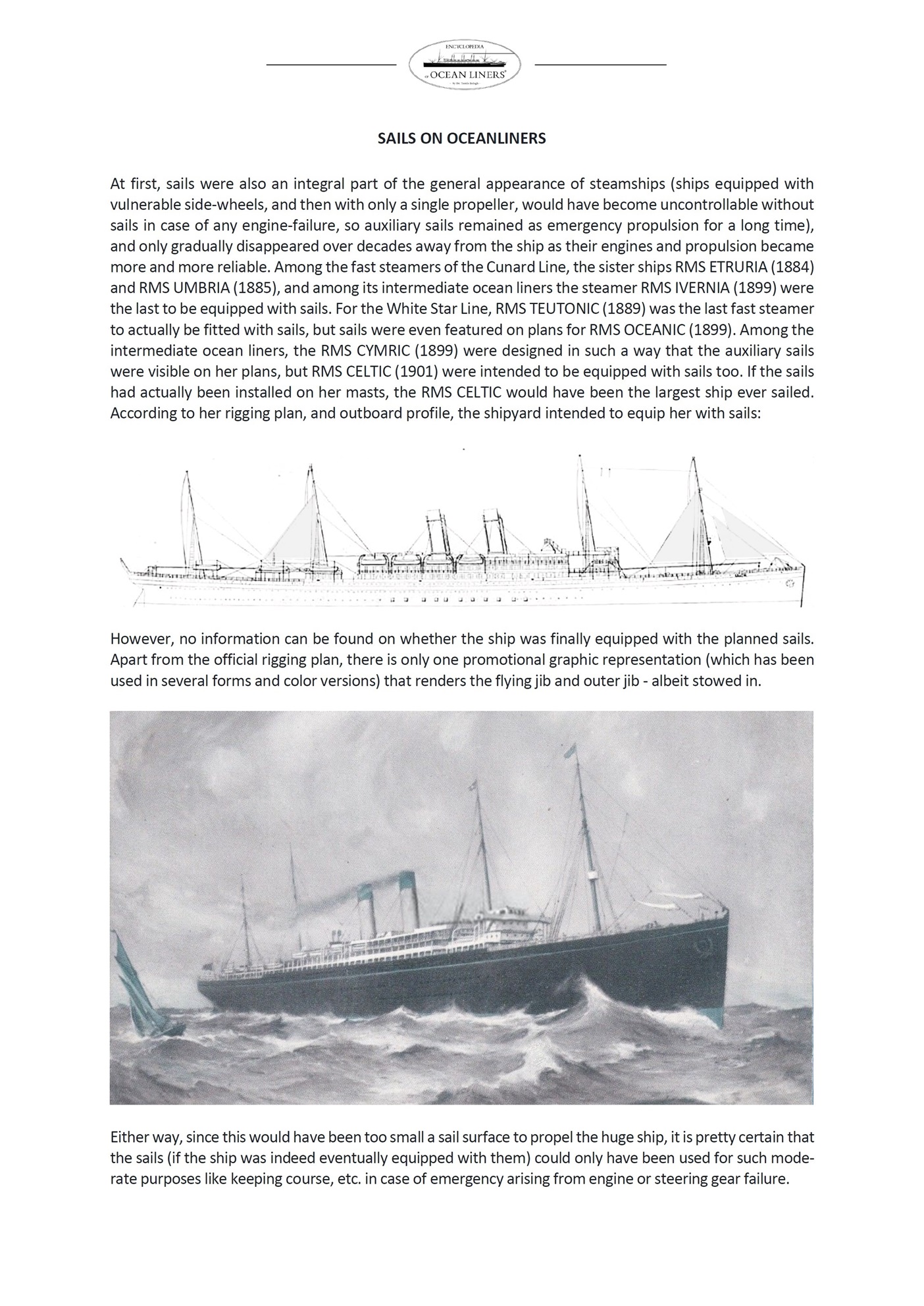
Fig. 10.: Information on whether CELTIC really had been equipped with sail.
26.07.1901.: CELTIC takes her inaugural voyage to New York.
04.08.1901.: At 07:00 in the morning the ship arrives in New York. The average speed measured under the voyage is 17 knots (31.5 Km/h), a full knot above the maximum speed prescribed in the specification.
To heat the 8 double-ended boilers located in the ship's two boiler rooms, only 2,400 tons of coal are needed during the entire journey to maintain a speed above 16 knots, while in the case of OCEANIC II, 6,000 tons are needed for crossing by 21-knots (CELTIC's daily coal consumption is 235 tons, OCEANIC 450). A total of 2,859 people (347 first-, 160 second- and 2,352 third-class passengers) can be accommodated in the ship's three classes, next to the crew of 335 (64 deck crew and officers, 92 engine room and stokehold crew, and 179 stewards).
Since most passengers can travel in third class, special attention is paid to the accommodation of the third class too: Separate cabins are created for almost two-thirds of all third class passengers, breaking with the previous practice of accommodation in large shared dormitories (although for the poorest single male passengers, there are 2 large sleeping compartments for 300 passengers each is maintained). In the aft part of the superstructure standing on the upper deck (on the saloon deck) there is a third-class smoking room and general room, and one deck lower there is a large dining room on the port- and starboard side of the hull. The rooms in the superstructure have the same seating furniture as the dining rooms, so they can also be converted into a dining room if the third class is fully booked. The third-class rooms are also equipped with electric fans, just like the other classes.
Although the hull can be loaded to a maximum draft of 36 feet 6 inches (11.25 m), it will only be allowed to fill to a draft of 31 feet (9.44 m) until the fairways of New York Harbor are dredged at a suitable depth to fit with the ship's maximum draft.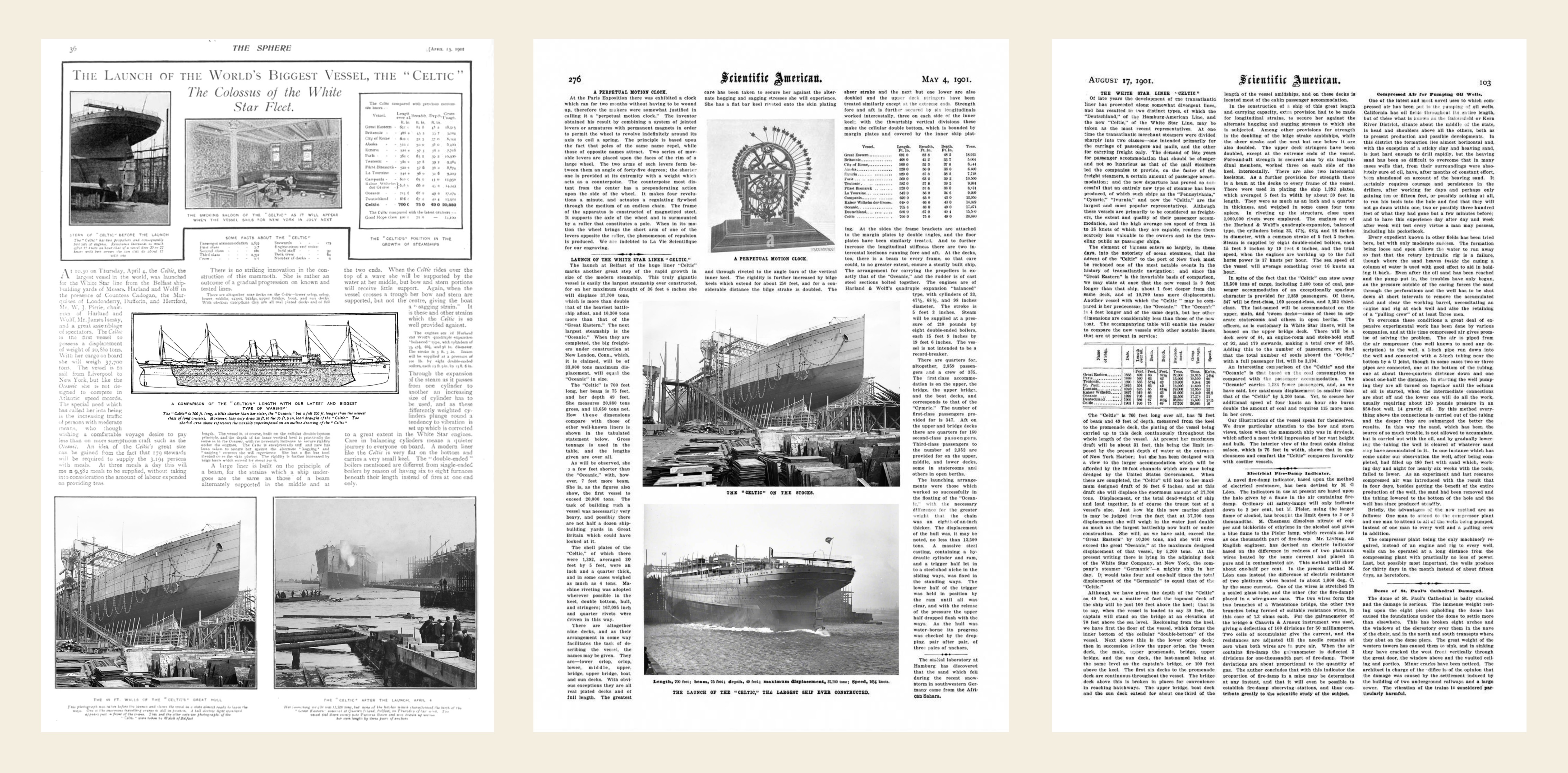
Fig. 11.: Issues of the contemporary press in Europe (left) and America (center and right) covering the birth of CELTIC, timed to the launch of the ship and her first arrival in America, detailing the ship's unique dimensions and equipment, as well as her cost-effectiveness. A typical excerpt from the August 17, 1901 issue of the scientific journal 'Scientific American': "The CELTIC can stow away 18,500 tons of cargo, including 2,400 tons of coal, passenger accommodation of an exceptionally spacious character is provided for 2,859 passengers. [...] An interesting comparison of the CELTIC and the OCEANIC is that based on the coal consumption as compared with the passenger accommodation. The OCEANIC carries 1,284 fewer passengers, and her maximum displacement is smaller than the CELTIC by 5,200 tons. Yet, to secure her additional speed of four knots an hour she burns double the amount of coal requires 115 more men in her crew." The image can be enlarged by clicking on the double arrow icon in the lower right corner. The image can be enlarged further into a readable size by selecting the "open image in a new window" command in the dialog box that appears when the mouse is placed over the enlarged image and click then with the right mouse button.
22.10.1901.: The CELTIC arrives in New York at the end of a voyage of 7 days, 12 hours, 41 minutes under the command of Captain Henry St-George Lindsay on her third voyage to New York.
31.12.1901.: CELTIC - which has completed 6 westbound Atlantic crossings since entering service - starts its 6th eastbound crossing, with a low occupancy typical of the winter period (only 233 passengers).
23.01.1902.: CELTIC's first arrival in New York that year.
02.08.1902.: CELTIC departs from New York on a 74-day Mediterranean cruise from New York to the Holy Land and back via Madeira, Gibraltar, North Africa, Malta, Egypt, Turkey, Greece Italy, the rench Riviera and England, with 826 American "Bible-students" in first class.
The "bible students" are members of the millennialist-restorationist Christian movement founded in 1881 by Pittsburgh Unitarian minister Charles Taze Russel (1852-1916), who believe that the original teachings and practices of Christ have been forgotten/distorted over the centuries and therefore require restoration, and the coming golden age will occur after the millennium.
The earliest history of the use of scheduled ocean liners for leisure cruises dates back to the operation of a British shipping company, the Peninsular & Orient Line (P&O), which first sold tickets for cruises in 1844 for its ships from London to the Mediterranean region. A similar service was first provided in America in 1867 by the s.s. QUAKER CITY, a wooden paddle-wheel steamer, whose passengers visited the ports of France, Italy, Greece, Turkey (the Holy Land) and Egypt (Mark Twain, who was on the ship, later wrote the novel "Innocents abroad" based on his experiences on board). The very first ship designed specifically for cruises (rather than be a scheduled ocean liner) - the British s.s. CEYLON - built in 1881, by which the Regent Street Polytechnic School offered affordable, educational leisure cruises to its working-class students. At that time, other organizations and shipping companies mostly offered cruises only with older ocean liners or ships that were not necessary for their other business activities in the off-season periods suitable for ocean crossings. Finally, in 1900, the director of the German company H.A.P.AG, Albert Ballin, ordered the first ship - the PRINZESSIN VIKTORIA LUISE - which was specifically designed for leisure shipping (until then, H.A.P.AG also used its reserve/out-of-service ocean liners for excursions). WSL also tried to catch up with this initiative by organizing the cruise, trying to use the ship economically in the off-season.
19.04.1902.: The American investment banker John Pierpont Morgan, who has been trying to monopolize the North Atlantic shipping market for years by buying shipping companies operating on both sides of the ocean, buys the majority of shares of the White Star Line for 10,000,000 pounds. Joseph Bruce Ismay will remain as president and CEO, while James Ismay and William Imrie will retire. As WSL's largest shareholder until then, the owner and director of the Harland & Wolff Shipyard, William James Pirrie, hastened the acquisition, not by chance: part of the deal is that all shipping companies owned by Morgan will then have all their ships built at the Harland & Wolff Shipyard in Belfast. As a result of the agreement, the shipyard builds more than 13 ships a year - i.e. one a month - and thus becomes the largest shipyard in the world.
05.03.1902.: CELTIC arrives in New York after returning to North Atlantic service following her Mediterranean cruise.
07.06.1902.: The keel of the third unit of the Big Four (yard number 352), is laid.
21.08.1902.: Launch of the second unit, No. 337, under the name CEDRIC.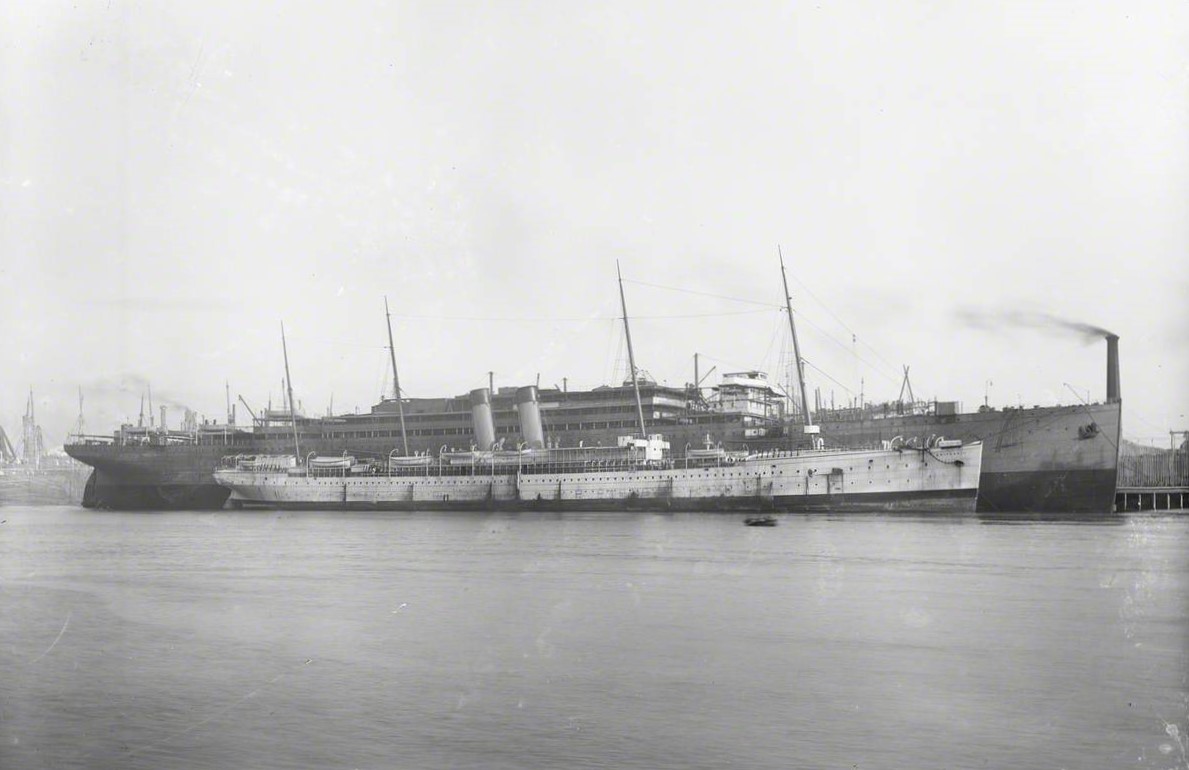
Fig. 12.: CEDRIC moored in the fitting out basin after launching, in company with BRITANNIC (I). The displacement of the CEDRIC exceeded her predecessors' by four times. (photo: Robert Welsh, Ulster Folk and Transport Museum, National Museums of Northern Ireland)
Fig. 13.: Development of White Star Line ships. Above left are half-models of OCEANIC (I), TEUTONIC and OCEANIC (II), while above right of CEVIC, RUNIC and CELTIC. (photo: Robert Welsh, Ulster Folk and Transport Museum, National Museums of Northern Ireland, 1st image, 2nd Image)
23.08.1902.: Order of the fourth unit of the Big Four (yard number 358).
18.11.1902.: The keel laying of the No. 358.
31.01.1903.: Official handover of CEDRIC.
15.04.1903: CELTIC collides with steamer HEATHMORE off Liverpool on the River Mersey. There is a small tear on the side plates of the hull above waterline, which needs to be repaired.
21.11.1903.: Launch of hull No. 352 under the name BALTIC.
26.11.1903.: A fire in the hold of the CELTIC destroys the cargo of cotton on board.
23.06.1904.: Official handover of BALTIC.
09.24.1904.: CELTIC arrives in New York with a crew of 2,957. So far, this is the highest number of people carried by White Star Line on a single voyage. In the same month, CEDRIC transports 2,723 passengers and BALTIC transports 2,890 passengers, i.e. the three units of the Big Four together transport 8,570 passengers across the Atlantic Ocean within three weeks. The correctness of the concept underlying the construction of the ships is thus clearly confirmed. So much so that following the success of the ships, the rival German shipping companies, H.A.P.AG and Norddeutscher Lloyd, decide to build similar ships (KAISERIN AUGUSTE VICTORIA, AMERICA and GEORGE WASHINGTON). Among the German ships, the AMERICA is built in Belfast at Harland & Wolff. This is spectacular evidence that William James Pirrie now considers the earlier agreement between Sir Edward Harland and Thomas Henry Ismay that the shipyard would not build ships for WSL rivals to be null and void.
12.03.-30.12.1905.: CELTIC makes 12 Atlantic crossings during the year under the command of Captains Joseph Barlow Ranson and Bertram Hayes. On her last trip to America that year, on December 25th, a giant rogue wave struck the ship, damaging the second-class facilities (the wave smashed the windows of the smoking room, tore a 4-ton boarding door from the hull, and swept away a 30-meter section of the deck railing, seriously scaring the for passengers).
A rogue wave – in contrast to a tsunami that is almost imperceptible in deep waters – is an episodic wave phenomenon that exists for a short time and is more than twice the height of the significant wave, which is formed when a normal - so-called: non-linear - wave gains energy from the surrounding waves as a result of the interaction of certain environmental factors like wind, currents, etc. (i.e. it is a result of linear superposition) and increases to many times its previous size for a while, posing a particular danger to shipping.
31.01.-07.12.1906.: CELTIC crosses the Atlantic 11 times during the year under the command of Captain Joseph Barlow Ranson.
20.09.1906.: Launch of the hull No. 358 under the name ADRIATIC.
25.04.1907.: Official handover of the ADRIATIC.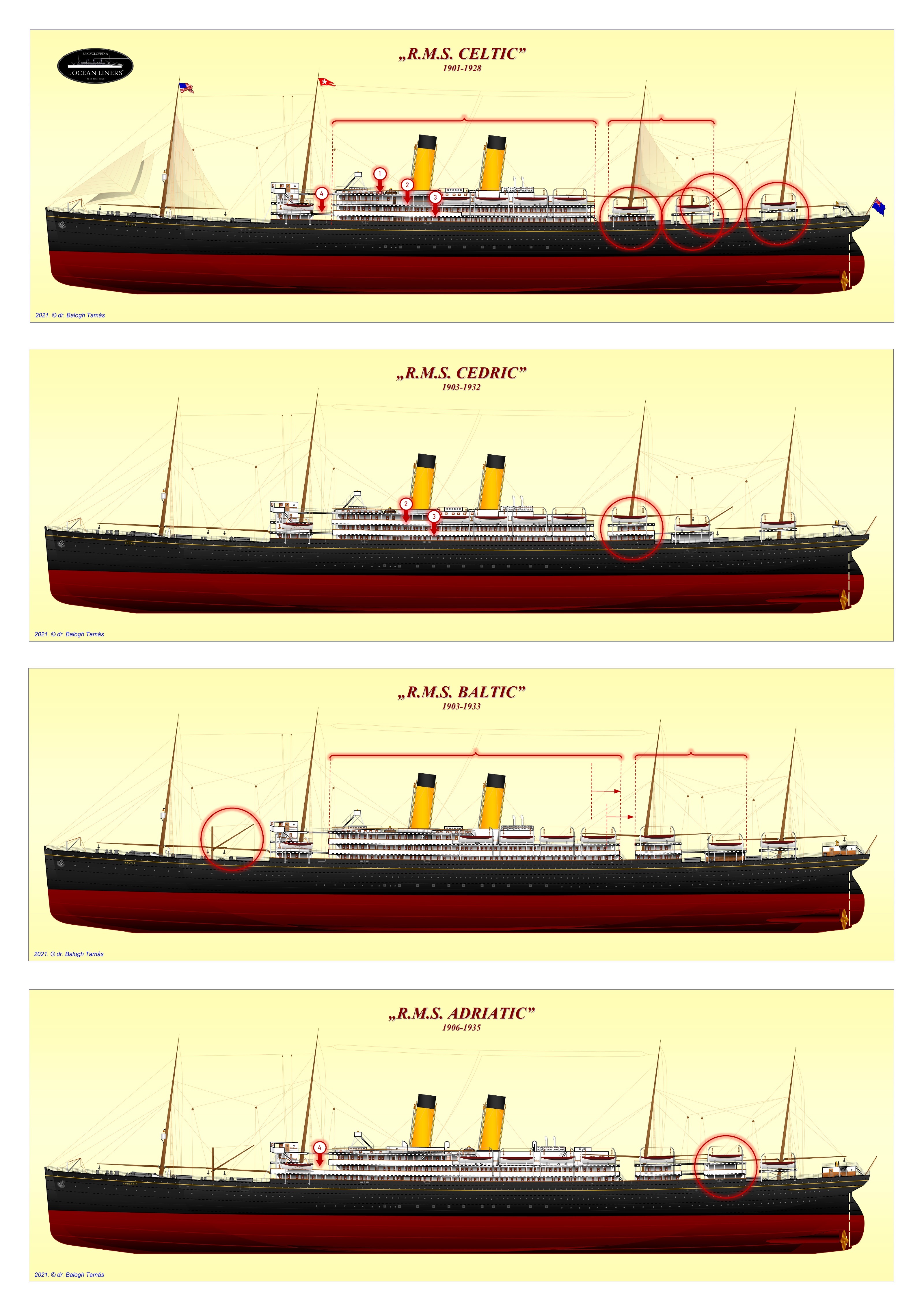
Fig. 14.: The ships of the Big Four look completely identical only at first glance. In fact, the first two units and the last two units are more similar to each other than to any member of the other pair. BALTIC and ADRIATIC, for example, with their displacement of 24,570 tons, are 17% larger than CELTIC and CEDRIC with her 20,904 tons. In the case of the ADRIATIC, the engine performance is also increased in order to increase the ship's speed above 17.5 knots (32.4 Km/h): so 4 extra single-ended boilers are also installed in addition to the 8 double-ended boilers. The above drawing shows the differences between the ships of the first and the second pairs (drawing: Dr. Tamás Balogh) as follows:
- The red circle shows the relative position and different installation of the three islands of the split-superstructure, formed at the rear of the ship (i.e. the presence or absence of rooms under the boat racks, bounded by side walls, and the different heights of the superstructure-islands), as well as shows the postion of deck cranes (where relevant - i.e. on a ship without such a marking, the arrangement is the same as on the previous ship).
- Red dashed lines mark the changes in the length of the middle part of the split-superstructure and the rear superstructure-group (which is formed by three islands), as well as the distance between them, in case of each ship (where relevant - i.e., on a ship without such a marking, the arrangement is the same as on the previous ship).
- The numbers 1-2-3-4 indicate the design and length of the parapets of the superstructures, which are different for each ship and deck (solid plate parapet or guardrails) (where relevant - i.e., on a ship without such a marking, the arrangement is the same as on the previous ship).
30.04.1907.: White Star Line commissioned Harland & Wolff Shipyard in Belfast to prepare for the construction of three large ocean-going passenger steamships (the later OLYMPIC class) and to start developing the detailed plans based on the customer's specifications.
20.10.1911.: Deck Steward Robert MacGuffie disappears (probably washed overboard by a giant wave). Passengers raise $500 to help his widow and children.
14.04.1912.: The BALTIC, which had set sail from New York three days ago, signals ice for the TITANIC on her maiden voyage to New York, and at dawn the next day, she tries to save her fleetmate that collided with an iceberg during the night.
18.04.1912.: Joseph Bruce Ismay wants to send home the surviving crew of the TITANIC aboard the CEDRIC, but due to the Senate hearings ordered in the meantime, the ship will return to Europe without them.
02.05.1912.: Joseph Bruce Ismay arrives in Liverpool aboard the ADRIATIC after the conclusion of the Senate inquiry (the surviving crew members of the TITANIC are transported back to England by the Red Star Liner LAPPLAND).
31.12.1912.: Joseph Bruce Ismay confirms that, in accordance with his January decision, resigns with effect on 6/30/1913. His decision was accepted on 01.02.1913. White Star Line's new president and CEO is the former vice president Harold Sanderson.
23.01.-05.12.1913.: CELTIC makes 11 Atlantic crossings during the year under the command of Captains Frank Ernest Beadnell and Alexander Elvin Sherwin Hambelton.
The economy of transoceanic passenger transport is unbroken despite the tragedy of the TITANIC: while in 1912 the ships of the Big Four transported a total of 68,000 people back and forth between the two sides of the ocean, in 1913 no less than 77,000 people, and by the end of 1914 the combined performance of the four ships, projected on the entire time since they were enter into service, meant a total of 850,000 people.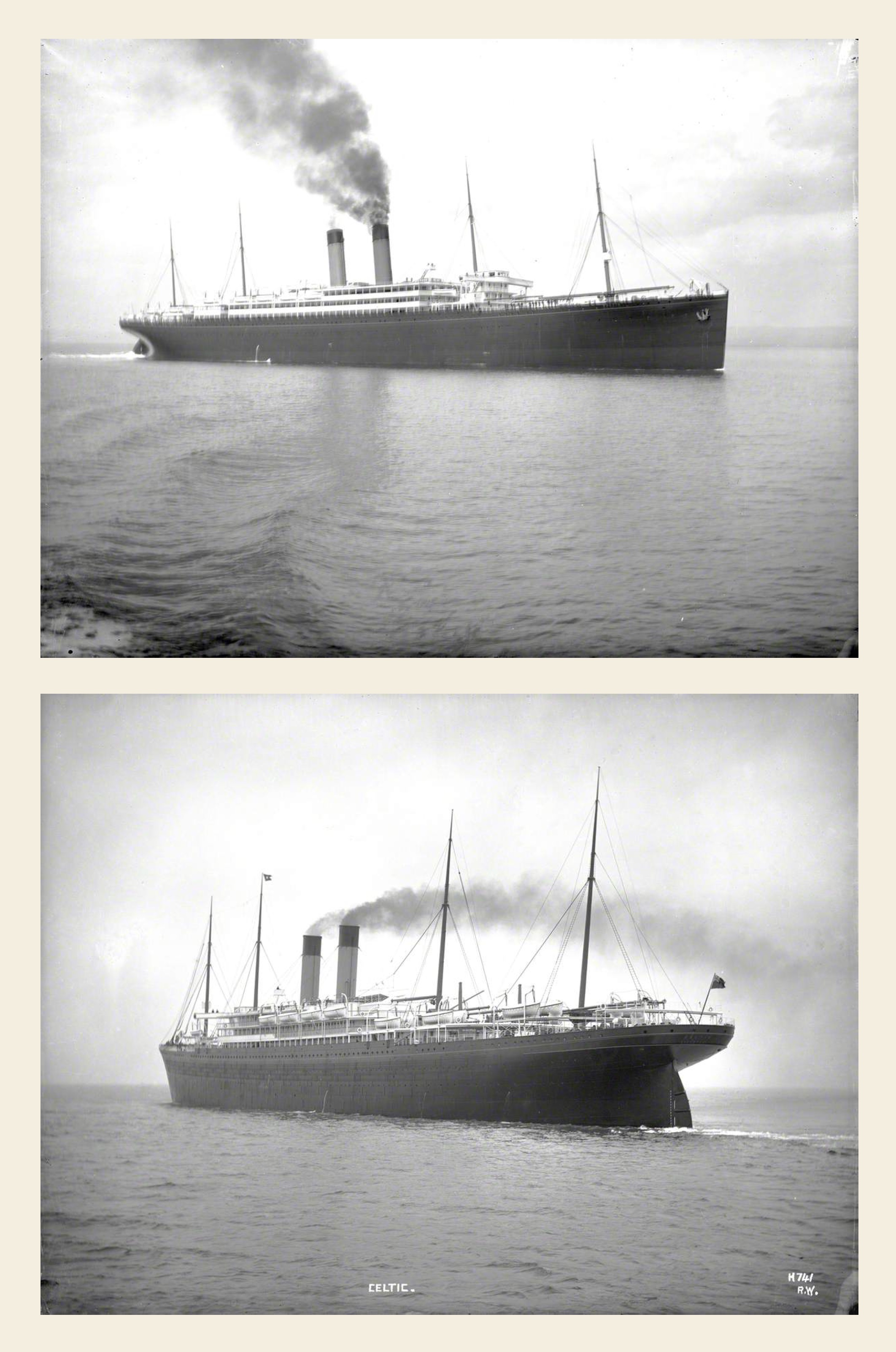
Fig. 15.: Despite her moderate speed, the CELTIC was one of the most popular ships of the period before the First World War. One of the reasons for this can be found in what Scientific American c. magazine summarized as follows: "At one time the transatlantic merchat steamers were divided sharply into two classes - one intended primrily for the carriage of passengers and mails, and tha other for carrying freight only. The demand of late years for passenger acommodation that shopuld be cheaper and not so luxurious as that of the mail steamers led the companies to provide, on the faster of the freight steamers, a certain amount of passenger accommodation; and the new departure has proved so successful that an entirely new type of steamer has been produced, of which such ships the CELTIC is the largest and most popular" (photo: Robert Welsh, Ulster Folk and Transport Museum, National Museums of Northern Ireland, 1st image, 2nd image).
08.01.-25.05.1914.: During the first half of the year, CELTIC makes 3 crossings between New York and Alexandria (Egypt), via Naples and Madeira under the command of Captain Alexander Elvin Sherwin Hambelton.
11.06.1914.-08.10.1914: CELTIC completes 5 Atlantic crossings between Liverpool and New York for the remainder of the year - including the period following Britain's entry into the First World War on 08/04/1914 - under the command of Captain Alexander Elvin Sherwin Hambelton.
01.11.1914-02.08.1915.: CELTIC is requisitioned by the Government: the ship is armed according to the contract between the shipping company and the British government (the ship is equipped with 8 6-inch quick-fireing naval guns) and is used as an auxiliary cruiser of the fleet during the war, under the command of Captain Oswald McDonough English, with the task of acting for the British fleet in the Pacific.
02.08.1915-04.01.1916.: CELTIC in military service under the command of Captain Christopher Russell Payne. The ship is in dry dock from 23/08/1915 to 07/09/1915 in Simonstown, South Africa, where the maintenance of her underwater parts will be carried out, and then she will remain in the bay until 12/1/1915, so that boiler and engine work can also be carried out.
19.04.-03.12.1916.: The CELTIC is discharged from the navy as armed merchantmen, and for the rest of the year, she is in service as a troop transporter, she completes 7 crossings of the Atlantic Ocean between Liverpool and New York and back under the command of Captain Alexander Elvin Sherwin Hambelton, who is appointed as the commander of the ocean liner JUSTICIA (ex-STATENDAM) at the end of the year.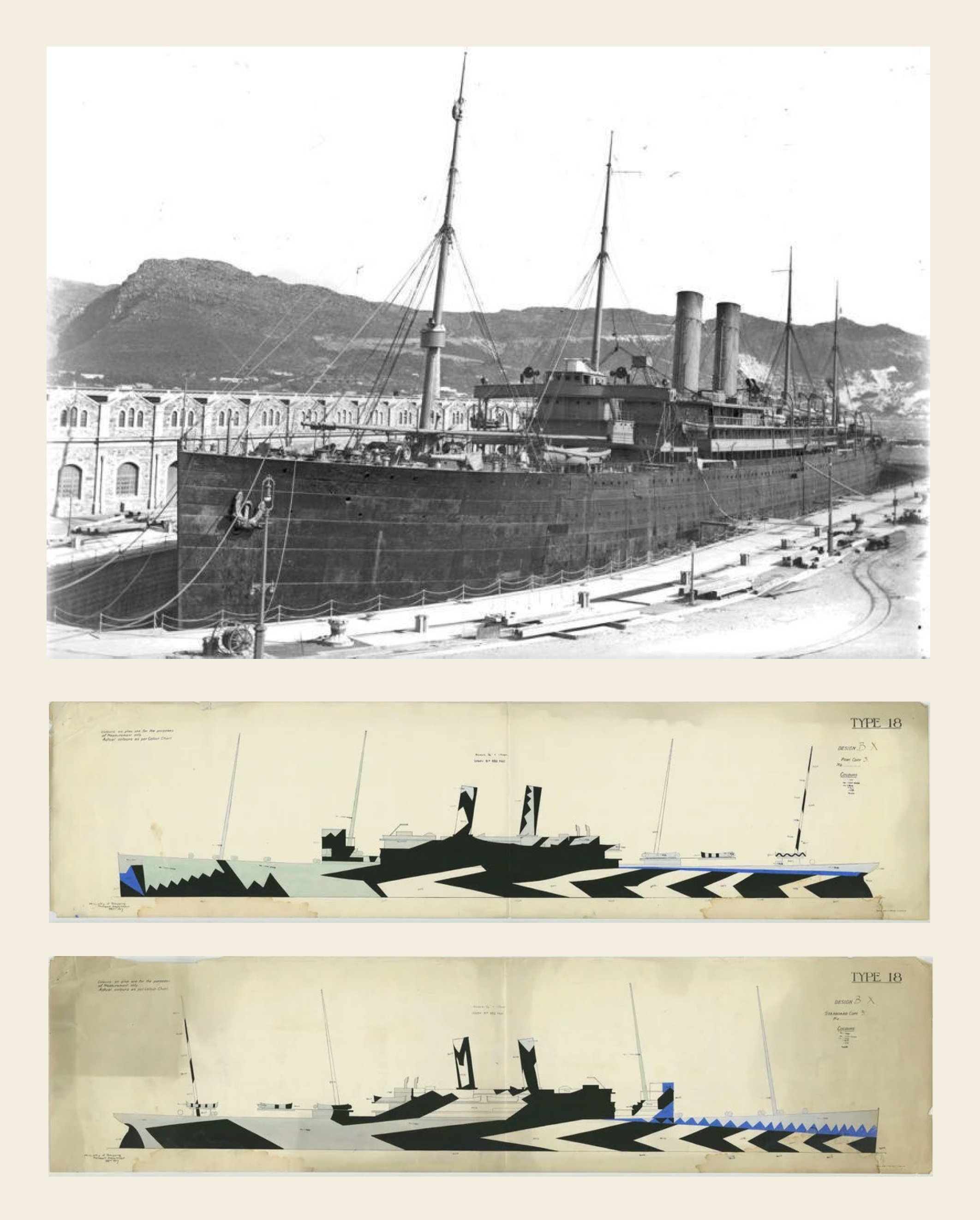
Fig. 16.: CELTIC as armed merchant cruiser in dry dock at Simonstown (above). The picture shows the quick-fireing naval guns installed on the edge of the bow deck and on the well decks between the superstructure-islands (source). Center and bottom shows the dazzle paint camouflage used to confuse submarine commanders after the ship was discharged from AMC-service (source).
03.01.-21.04.1917.: CELTIC makes two voyages between Liverpool and New York under the command of Captain John Bradshaw.
14.02.1917.: CELTIC hits by a naval mine off the Isle of Man. 17 people on board die, but the ship remains afloat and is towed by the steamer CANADA to Peel Bay, from where she is later towed to Belfast, where she is completely repaired and then converted to transport fuel oil for naval vessels.
13.05.1917.: Unsuccessful torpedo attack against the ship by the German submarine U-57 (the torpedo misses its target).
11.06.-26.12.1917.: After the repair works, CELTIC completes 5 more Atlantic crossings between Liverpool and New York and back under the command of Captain Hugh Frederick David.
27.02.-17.12.1918.: CELTIC completes 3 Atlantic crossings between Liverpool and New York and back under Captains Hugh Frederick David and Alexander Elvin Sherwin Hambelton.
31.03.1918.: The submarine U 77 torpedoes the ship in the Irish Sea. Six die, but the CELTIC remains afloat this time as well (according to the sailors, this is because the submarine torpedoed her from both sides, so that, despite being flooded, the cargo did not moves away). She is managed to be towed to Liverpool, where she is repaired again.
17.05.1919: CELTIC is returned by the British government to the White Star Line, which sends her to Belfast for renovation.
01.01.-29.12.1920.: CELTIC completes 9 crossings of the Atlantic between Liverpool and New York under the command of Captain Richard Owen Jones.
08.01.-26.12.1921.: CELTIC completes 12 Atlantic crossings between Liverpool and New York and back under the command of Captains Frank Briscoe Howarth, Frank Ernest Beadnell and John Roberts.
24.04.1921.: The collier EVERETT nearly ramms with the CELTIC in dense fog near the lightship NANTUCKET. The collision is avoided at the last moment, but CELTIC's side dents, where the collier scour along it.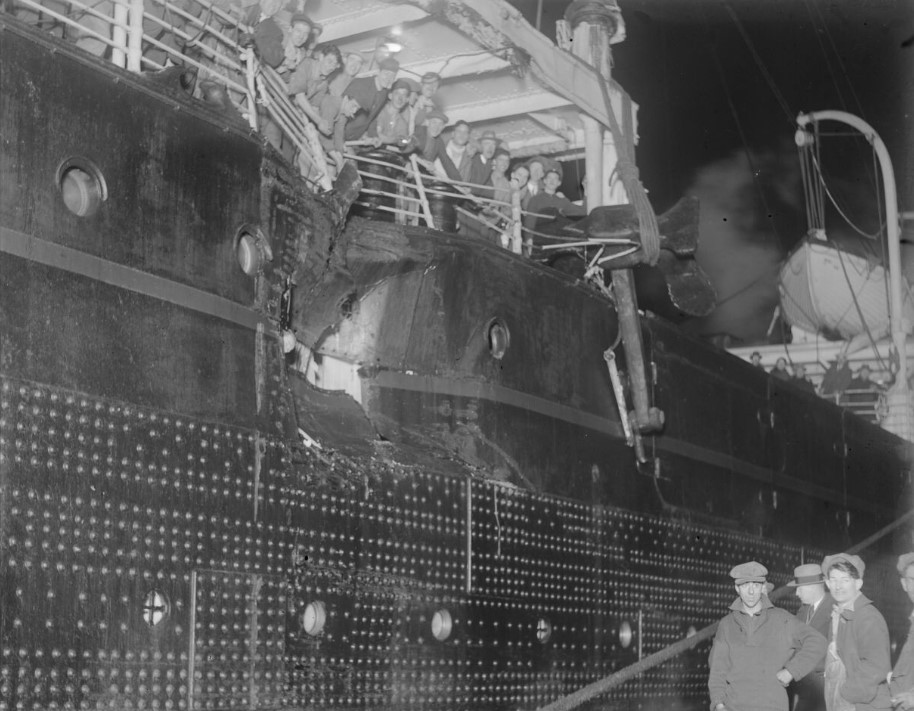
Fig. 17.: Damaged side-pates of CELTIC after the collision. (photo: Leslie Jones, Boston Public Library, Leslie Jones Collection)
18.02.-11.12.1922.: CELTIC completes 11 crossings of the Atlantic between Liverpool and New York under the command of Captains John Roberts and William Marshall.
25.04.1925.: CELTIC accidentally collides with the Coast Liner HAMPSHIRE COAST on the River Mersey. Both ships only sustain minor damage. That same year, the CELTIC loses a propeller in Boston Harbor and must return to dock, so her passengers take a train to New York to transfer to another ship.
01.11.1926.: Lord Kylsant, the owner and CEO of the British Royal Mail Steam Packet Co. and H&W, buys the majority of the shares of the White Star Line back from its American owners, who announce that they will terminate the contract with the Harland & Wolff Shipyard. The White Star Line changes from American to British ownership and joins the conglomerate led by the Royal Mail Steam Packet Co.
29.01.1927.: American Diamond Lines ship ANACONDA collides with CELTIC near Fire Island in heavy fog. The post-accident refit will be used by White Star Line to remodell the ship, so that CELTIC can keep up with the latest intermediate ships entering service in the North Atlantic. The previous three-class system will then be abandoned, and the ship will be equipped for 2,500 cabin class passengers.
14.04.1927.: Laying of the keel of BRITANNIC (III), a modern medium-sized cabin motor ship ordered to replace the aging Big Four.
01.12.1928.: The CELTIC sets sail from New York to Boston, where it takes on board the European survivors of the steamer VESTRIS, which sank on November 12, and then begins her Atlantic crossing to Cobh, Ireland, and Liverpool, England, under the command of Captain Gilbert Parry. The ship is expected to arrive in Cobh between 03:00 and 04:00 a.m. on December 10th.
10.12.1928.: CELTIC runs aground.
Approaching Cobh, the weather worsened, threatening to make it impossible to pick up the pilot, whose presence is necessary for a safe approach to the anchorage in front of the harbor. Captain Gilbert Berry therefore decides that if the weather does not improve, he will skip the stop in Ireland and go directly to Liverpool. The pilot who is prepared to welcome the CELTIC, sights the lights of the liner at 03:00 AM, a few miles away south-east of the entrance to Cobh harbor. Although the strong south-westerly wind is increasing to a gale in the meantime, Captain Berry believes that he will be able to pick up the pilot during the predicted high tide of 04:11, so he slowly approaches the harbor entrance with the CELTIC. She is almost in safe water, when at 04:55 a strong gust of wind drove her onto the Cow and Calf rocks off Roche's Point with a loud crash. As a result of the powerful impact, the porcelain and glass in the dining room falls from the tables onto the deck and breaks, several passengers lose their balance and fall, while CELTIC's hull swaying from side to side on the waves, and trembling as the still rotating propellers try to propel the ship stucked on the rock.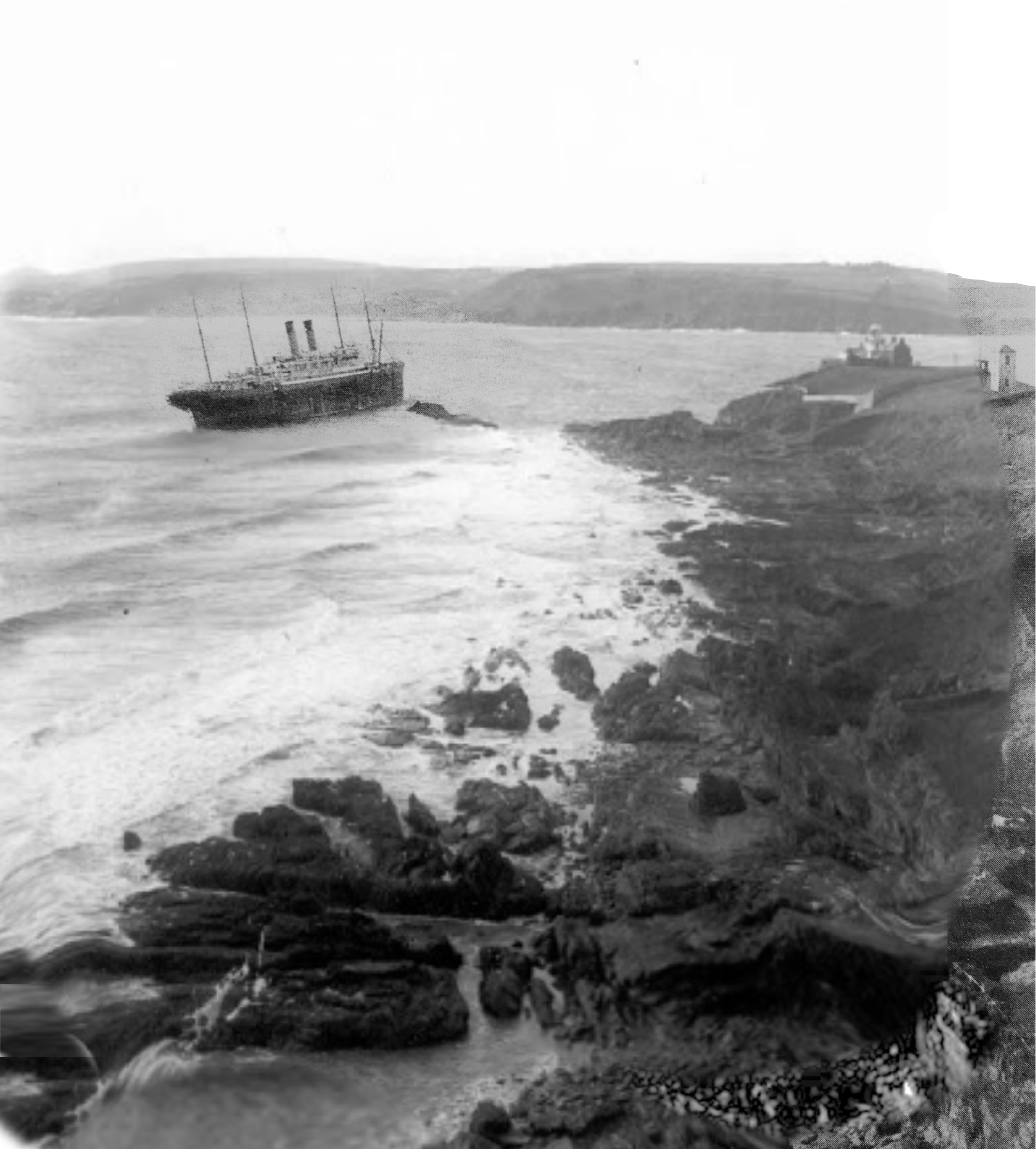
Fig. 18.: CELTIC on the rocks. (Source)
Captain Berry blows six short blasts on the CELTIC's steam whistle to signal to nearby vessels that he is requesting rescue, and the stewards walk through the cabins calling for passengers to put on their life jackets and assemble on the boat deck. Among them is steward Albert Knill, one of the 13 survivors who escaped in VESTRIS lifeboat No. 13, who was rescued from the sea on the 13th of November, the day after the ship sank, in his 13th year of service at sea. Although this is the second shipwreck in a short time, it feels like a real picnic compared to what he experienced on board the VESTRIS, since barely ten minutes after the collision, the CELTIC's stewards are already serving hot coffee to those gathered on the boat deck. The lifeboats are swung out ready to be lowered and passengers are prepared to board the boats, but the operation, which was considered too dangerous in stormy weather, was soon called off when it became clear that the ship was not in immediate danger of sinking, so the passengers were guided back inside the ship, and at the usual time, 06:30 AM., they were served breakfast in the dining room, where the tables were set as usual, as if nothing had happened.
Meanwhile, the rescue ships - the Dutch tug GELEZEE and the local tug MORSECOCK - try to get close to the CELTIC without success. They only manage to take over the towing ropes well after breakfast, and then they attempt to pull the ocean liner off the rock, but after several hours of attemts, they finally give it up, as the tide recedes, making the task impossible. In order to lighten the ship, the passengers and luggage are taken out with the help of tugboats, and the passengers are taken by train to Belfast, from where they arrive in Liverpool at 06:00 AM the next morning. Only the officers, engineers and deck crew remain on board, knowing full well that every minute spent on the rock, brings CELTIC's final destruction closer and closer. At 15:30, the destroyer HMS SEAME of the British Royal Navy tries to tow the ocean liner off, which tries to help the success of the operation with running engines. At 17:00 p.m., however, the attempt is abandoned, as the flooding inside the CELTIC begins to rise. At 17:30 it is already 12 ft (3.7 m) deep in No 3 holds, 11 ft (3.4 m) deep in No 3 and 5 stokeholds, and 3 ft (0.9 m) deep in the engine room, above the tank top, and one of the tanks built into the double bottom is completely full. In such circumstances, further operation of the engines is impossible, and towing into deep water threatens to sink the ship.
11.12.1928.: The water level rises to 25ft (7.2m) in No 3 hold, but the situation worsens in the other compartments affected by the flooding as well. Using hand pumps, the crew are trying to reduce the amount of about 6,000 tons of water that broke in, and at the same time keep the situation under control. Charles Alfred Bartlett, chief marine superintendant of the White Star Line (last commander of TITANIC's younger sister, the BRITANNIC (II) at the time of her sinking in 1916) arrives on the scene, and after inspecting the CELTIC, he makes it likely that the rock supports the ship just forward of the navigating bridge, so in the midship area accumulates a lot of tension, as the strong waves hit the ship's hull again and again. Negotiations with the Chief Marine Inspector of Cobh, the representatives of the Harland & Wolff Shipyard and the insurance companies begin in the ship's dining saloon, the result of which is that even if it were possible to tow the ship off the rock and keep her afloat, even then it is questionable where she could be repaired. They finally decide to beach her at Whitebay, a few miles away, where they can carry out the most necessary repairs to get the ship to Belfast, where she can be completely repaired. The rescue ships already on the scene will be joined by the German SEEFALKE and the British RESTORER tugs. Four tugboats are now trying to free CELTIC - to no avail.
14.12.1928.: With the exception of the fore and aft peaks (trim tanks) at the bow and at the stern, as well as No 1 hold, the entire ship is flooded of flooding fore and aft. The cargo - vegetables and grain - can only be unloaded from the starboard side of No. 1 and No. 2 cargo holds.
18.12.1928.: Intensive pumping in the engine room reveals extensive damage to the ship's bottom. Since the leak cannot be approached, it cannot be closed either, so rescuing the ship is impossible.
28.12.1928.: The removal of the several thousand tons of cargo left in the ship begins.
03.02.1929.: Last attempt to towing off the CELTIC. The operation, timed for the peak of the tide, has to be interrupted due to the wind intensifying into a gale.
29.07.1929.: WSL sells the wrecked ship to the Danish shipbreaking company Peterson & Albeck of Copenhagen, who offer a 50% share to Hills of Dover Shipbreakers, who begin dismantling the wreck in situ.
First, the funnels will be removed, as they prevent the light signals of the lighthouse at Roche"s Point from being clearly visible from the sea, then three of the 4 masts will be removed, and finally all the superstructures will be demolished up to the level of the upper deck. According to the original plans, the remaining hull would be towed to Rotterdam, but when it turned out that it was still not possible to tow her off the rocks, they decided to cut her up in situ. The transportation of the dismantled material was originally planned to be carried out by help of a floating crane moored on the seaward side of the ship, but due to the weather it was not possible to secure the crane, and on the shore side, due to the conditions of the sea bed, only a crane with a much smaller load capacity could be placed next to the ship on a tied pontoon, so finally another crane is built on board the CELTIC to carry out the demolition with the coordinated work of the two cranes. The process is hindered by the toxic gases released during the rotting of the perishable goods left in the holds - bacon, grain - and the soggy coal left in the coalbunkers, from which they try to protect the breakers with the use of gas masks, who finally managed to finish the breaking of the ship's hull by 1933.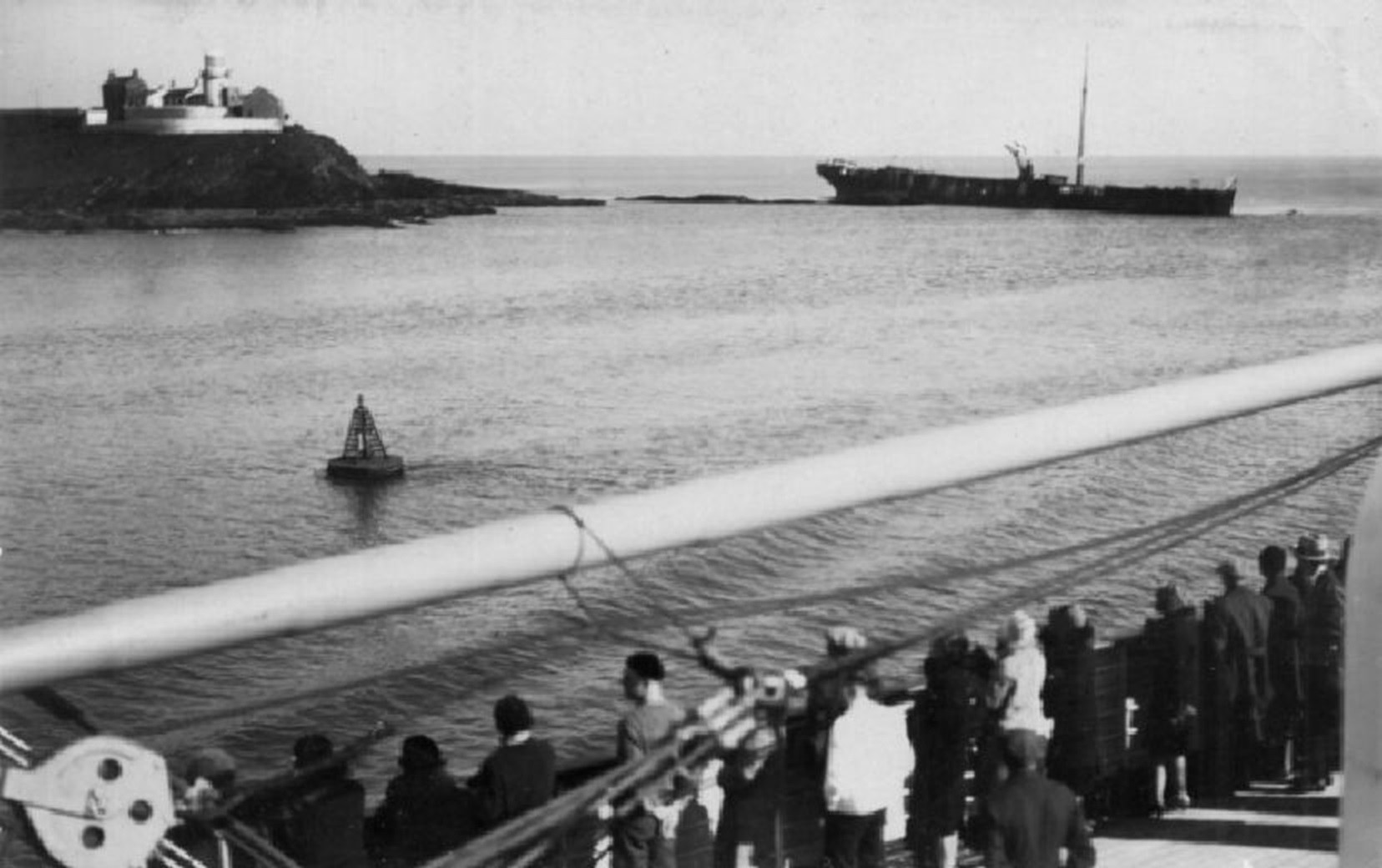
Fig. 19.: The progress of the demolition in 1932. (Source)
Sources:
Chirnside, Mark: The ‘Big Four’ of the White Star Fleet: Celtic, Cedric, Baltic & Adriatic, The History Press 2017. ISBN-10 0750965975
de Kerbrech, Richard: Ships of the White Star Line. Shepperton: Ian Allan Publishing. ISBN 978-0-7110-3366-5
Eaton, John; Haas, Charles: Falling Star, Misadventures of White Star Line Ships. Patrick Stephens Ltd. 1989. ISBN 1-85260-084-5
Norway Heritage: The emigrant ship database, CELTIC (II)
Othfors, Daniel: CELTIC (II), in.: The Great Ocean Liners
The famous Big Four: brochure of the White Star Line, 1909.
It would be great if you like the article and pictures shared. If you are interested in the works of the author, you can find more information about the author and his work on the Encyclopedia of Ocean Liners Fb-page.
If you would like to share the pictures, please do so by always mentioning the artist's name in a credit in your posts. Thank You!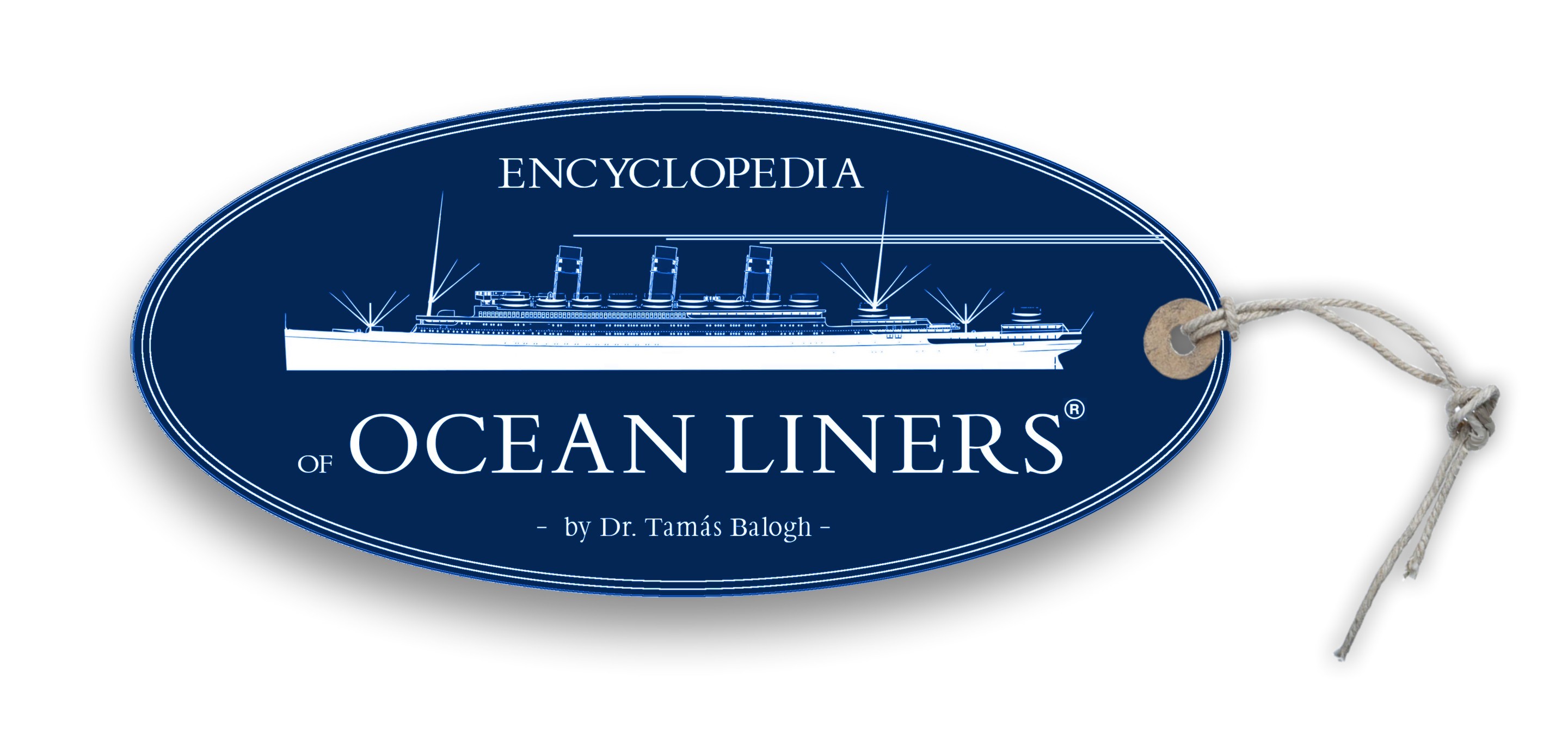

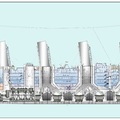
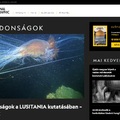
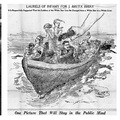
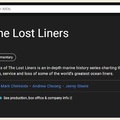
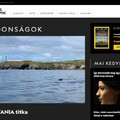
Utolsó kommentek